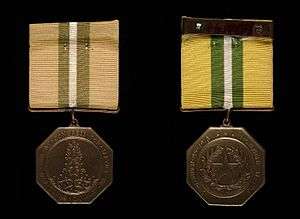Texas Cavalry Medal
| Texas Cavalry Medal | |
|---|---|
|
Obverse and reverse of the Texas Cavalry Medal | |
|
Awarded by the United States Department of War | |
| Country |
|
| Type | Service medal |
| Eligibility | Officers and enlisted men of the two brigades of cavalry organized by the State of Texas, under authority from the War Department |
| Awarded for | Service on the Mexican border from December 8, 1917 to November 11, 1918 |
| Status | No longer awarded |
| Statistics | |
| Established | April 16, 1924 |
| Distinct recipients | 840 |
| Related | Mexican Border Service Medal |
|
Ribbon of the medal | |
The Texas Cavalry Medal was a federal service medal, approved by the United States Congress and awarded to the members of the cavalry brigades raised by the State of Texas who were not called into federal for service in 1917 and 1918, rendering the men of those two units ineligible for the World War I Victory Medal.[1] Qualifying dates of the Texas Cavalry Service Medal were from December 8, 1917 to November 11, 1918.[2] Only 840 medals were awarded for this time period.
The Texas Cavalry Medal was created by Congress to commemorate federal service, and is the only medal specifically for state troops awarded by the federal government.[3][4] For this reason, the legislation authorizing the Texas Cavalry Medal specifically authorizes its wear on active duty United States military uniforms.[2] The Italian-American sculptor Anthony de Francisci designed the medal.
Appearance
The medal was designed by Anthony de Francisci based on design and imagery criteria specified by The Equipment Branch, Quartermaster General Department of the Army. The approved design is a bronze hexagonal medal 1 1⁄8 inches (29 mm) in diameter. The obverse of the medal depicts the bluebonnet, the state flower of Texas. Inscribed around the edge are the words AWARDED • BY • CONGRESS • FOR • SERVICE; at the top of the medal and TEXAS • CAVALRY; at the bottom of the medal. The reverse of the medal bears the Coat of arms of Texas, a Lone Star encircled by a wreath, surrounded by the dates of service in 1918 when the cavalry became eligible for federal activation and the signing of the armistice to end World War I.[5]
References
- ↑ "1922 to 1938". Brigadier General John C.L. Scribner Texas Military Forces Museum. Retrieved 1 February 2012.
- 1 2 "
 Chapter 117". An Act Authorizing the issuance of service medals to officers and enlisted men of the two brigades of Texas cavalry organized under authority from the War Department under date of December 8, 1917, and authorizing an appropriation therefor; and further authorizing the wearing by such officers and enlisted men on occasions of ceremony of the uniform lawfully prescribed to be worn by them during their service.. 43. Washington D.C.: Government Printing Office. Wikisource. 1925.
Chapter 117". An Act Authorizing the issuance of service medals to officers and enlisted men of the two brigades of Texas cavalry organized under authority from the War Department under date of December 8, 1917, and authorizing an appropriation therefor; and further authorizing the wearing by such officers and enlisted men on occasions of ceremony of the uniform lawfully prescribed to be worn by them during their service.. 43. Washington D.C.: Government Printing Office. Wikisource. 1925. - ↑ Doubler, Michael D.; Listman Jr., John W. (2007). The National Guard: An Illustrated History of Americas Citizen-soldiers (2nd ed.). Washington, D.C.: Potomac Books. p. 61. ISBN 9781574887037. Retrieved 9 September 2015.
- ↑ Annual report of the Chief of the Militia Bureau. Washington D.C.: Government Printing Office. 1926. pp. 54–55. Retrieved 9 September 2015.
- ↑ Luce Foundation Center for American Art. "Sculpture: Medals: Texas Cavalry Medal". Smithsonian American Art Museum. Smithsonian Institution. Retrieved 9 September 2015.
